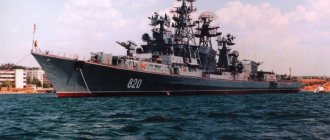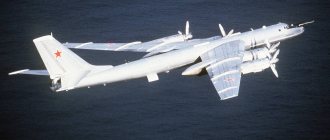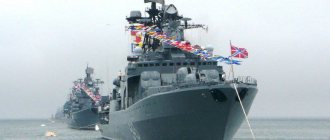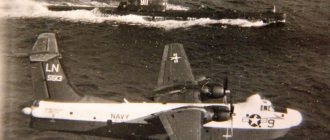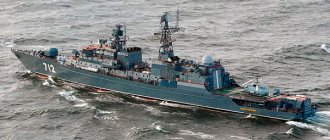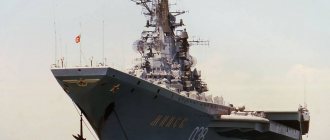Large anti-submarine ships of Project 1155
Large anti-submarine ships of the “Udaloy” (project 1155) – 12+1 units
The new generation of BODs are similar in displacement and dimensions to Project 956 destroyers. Essentially, they are a gas turbine version of destroyers with anti-ship missile systems and vertical launch air defense systems. The last ship of the Admiral Chabanenko series, instead of 100 mm guns and the Rastrub anti-ship missile system, is armed with 1x2 130 mm AK-130 gun and 2x4 Moskit anti-ship missile launchers.
“UDALOY” (serial number 111). On April 14, 1976, she was added to the list of Navy ships and on July 23, 1977, she was laid down at the Yantar Baltic Shipyard in Kaliningrad, launched on February 5, 1980, entered service on December 31, 1980, and included in the composition on January 24, 1981. CSF. 26-30.3.1984 paid a visit to Havana (Cuba). In the period from October 24, 1988 to January 19, 1990, a major overhaul took place in Kronstadt.
“VICE ADMIRAL KULAKOV” (serial number 731). On July 13, 1977, it was added to the list of Navy ships and on November 4, 1977, it was laid down at the A.A. Zhdanov plant (Northern Shipyard) in Leningrad, launched on May 16, 1980, and entered service on December 29, 1981 and 9.2. 1982 included in the KSF. On November 3-7, 1988, he paid a visit to Havana (Cuba). On March 19, 1991, it was delivered to Severomorsk for major repairs.
“MARSHAL VASILEVSKY” (serial number 732). 20.2.1978 was included in the list of Navy ships and 22.4.1979 was laid down at the A.A. Zhdanov plant in Leningrad, launched on 12/29/1981, entered service on 12/8/1983 and included on 1/18/1984 into the KSF.
“ADMIRAL ZAKHAROV” (serial number 112). On June 11, 1979, she was added to the list of Navy ships and on October 16, 1981, she was laid down at the Yantar Baltic Shipyard in Kaliningrad, launched on November 4, 1982, entered service on December 30, 1983, and included in service on January 18, 1984. KTOF. 11/29–12/3/1987 paid a visit to Bombay (India) and 5/12–16/1988 to Wonsan (North Korea). 1 On February 7, 1991, it was severely burned out as a result of a fire, after which it was not restored and on September 29, 1994 it was put into the dock for welding the outboard holes in connection with the upcoming sale for scrapping.
“ADMIRAL SPIRIDONOV” (serial number 113). On July 28, 1981, she was included in the list of Navy ships and in 1981 was laid down at the Yantar Baltic Shipyard in Kaliningrad, launched in February 1983, entered service on December 30, 1984, and was included in the KTOF on March 4, 1985. . 4 - 8.7.1986 paid a visit to Wonsan (North Korea) and 8-12.8.1991 - to Bombay (India).
“ADMIRAL TRIBUTS” (serial number 733). On June 11, 1979, she was included in the list of Navy ships and on April 19, 1980, she was laid down at the A.A. Zhdanov plant (Northern Shipyard) in Leningrad, launched on March 26, 1983, and entered service on December 30, 1985 and 15.2. 1986 included in the KTOF. November 18 – 23, 1987, visited Aden (South Yemen) and May 16 – 21, 1990, to Penang (Malaysia). From 5.12. From 1992 to 23.5.1993 he was part of a detachment of peacekeeping forces to maintain order in the Persian Gulf. Since March 22, 1994 it has been in reserve.
“MARSHAL SHAPOSHNIKOV” (serial number 114). 18.3.1982 was included in the list of Navy ships and in 1983 was laid down at the Yantar Baltic Shipyard in Kaliningrad, launched in January 1985, entered service on 12/30/1985 and included in the KTOF on 15/2/1986 . November 29 – December 3, 1987 paid a visit to Bombay (India) and August 14 – 18, 1990 to Wonsan (North Korea). On November 25, 1993, it was delivered to Dalzavod in Vladivostok for major repairs.
“SIMFEROPOL” (serial number 115, from January 24, 1996 – “SEVEROMORSK” ). On October 26, 1983, it was added to the list of Navy ships and on June 12, 1984, it was laid down at the Yantar Baltic Shipyard in Kaliningrad, launched on December 24, 1985, entered service on December 30, 1987, and included in the composition on May 1, 1988. CSF. 16 – 20.7.1991 paid a visit to Mayport (USA).
“KHABAROVSK” , from May 24, 1982 “ADMIRAL LEVCHENKO” (serial number 734). On August 1, 1981, she was included in the list of Navy ships and on January 27, 1982 she was laid down at the A.A. Zhdanov shipyard (Northern Shipyard) in Leningrad, launched on February 21, 1985, and entered service on September 30, 1988 and 1.5. 1989 included in the KSF. 11 -15.10.1993 paid a visit to Toulon (France).
“ADMIRAL VINOGRADOV” (serial number 116). On July 21, 1983, she was included in the list of Navy ships and on February 5, 1986, she was laid down at the Yantar Baltic Shipyard in Kaliningrad, launched on June 4, 1987, entered service on December 30, 1988, and included in the composition on May 1, 1989. KTOF. 31.7 – 4.8.1990 paid a visit to San Diego (USA).
“ADMIRAL KHARLAMOV” (serial number 11 7). On July 21, 1983, she was included in the list of Navy ships and on August 7, 1986, she was laid down at the Yantar Baltic Shipyard in Kaliningrad, launched on June 29, 1988, entered service on December 30, 1989, and included in the composition on April 1, 1990. CSF. 30.6 – 5.7.1993 paid a visit to Halifax (Canada), 7 - 11.7.1993 - to Boston (USA) and 8 - 11.7.1994 - to Rotterdam (Holland).
“ADMIRAL PANTELEV” (serial number 118). On May 24, 1987, it was included in the list of Navy ships and in 1987 it was laid down at the Yantar Baltic Shipyard in Kaliningrad, launched in 1988, entered service on December 19, 1991, and on May 1, 1992 it was included in the KTOF. 23 -30.8.1993 paid a visit to Qingdao (China) and 31.8 - 4.9.1993 - to Busan (Republic of Korea).
“ADMIRAL CHABANENKO” (serial number 121). On May 24, 1987, she was included in the list of Navy ships and in 1990 was laid down at the Yantar Baltic Shipyard in Kaliningrad, launched on June 16, 1994. Entered service on February 20, 2000.
Displacement: full – 7480 t standard – 6840 t length – 163 m beam – 19 m draft – 7.8 m Gas turbine power 4 x 20000 hp travel speed: maximum – 29.5 knots, economic – 14 knots. economical cruising range is 6882 miles. Armament: 2x4 launchers of the Rastrub anti-aircraft missile system (8 missile-torpedoes), 8x1 launchers of the Kinzhal air defense missile system (64 missiles), 1x2 100-mm AK-100 and 4x6 30-mm AK-630M guns, 2x4 533- mm TA, 2x12 RBU-6000 (96 RGB-60), 6-26 min, 2 Ka-27 helicopters. Crew 293 people.
Reliable sailors
Admiral's initiative: the Russian fleet will receive a mini-missile cruiser
What tasks will the updated large anti-submarine ship be able to solve?
As sources in the Russian military department told Izvestia, the plan for completing work on the large Project 1155 anti-submarine ship Admiral Levchenko has now been approved. According to the document, the ship should enter the fleet by the end of 2022. According to sources, gas turbine propulsion engines on the BOD were repaired, cooling units and shut-off valves were replaced. The ship's onboard electronics and fire-fighting equipment were also partially modernized.
The modernization will make it possible to permanently extend the service life of one of the largest and most active warships of the Northern Fleet, Izvestia sources noted. Also, according to the publication’s interlocutors, the issue of installing the latest Russian anti-submarine system “Otvet” on the ship is being considered. In December of this year, the frigate Marshal Shaposhnikov successfully hit an underwater target in the Sea of Japan with such a missile. This new system was first announced in 2019 by Deputy Defense Minister Alexei Krivoruchko, who is responsible for new developments and production of weapons. At the same time, he said that the new missile was planned to be put into service in 2022.
Photo: Russian Ministry of Defense
Launch of the Otvet complex rocket
“Daly” frigate: the Pacific borders will be protected by a ship with “Zircons”
The Admiral Vinogradov BOD will be modernized and equipped with powerful missiles
“Admiral Levchenko” waited a long time for repairs. It docked at the port of Severomorsk back in 2014. Before this, he made a long voyage to the Mediterranean Sea as part of an aircraft carrier group of the Northern Fleet. During it, he operated off the coast of Syria together with the heavy aircraft-carrying cruiser Admiral of the Fleet of the Soviet Union Kuznetsov.
The Project 1155 BOD, although it has been in service for at least 35 years, will still serve, says former Chief of the Navy General Staff, Admiral Valentin Selivanov.
“Currently the Navy lacks large ships that must operate in the oceans,” he told Izvestia. “These BODs have good driving performance, which allows them to stay away from their native shores for a long time. When modernizing these ships, special attention should have been paid to updating anti-submarine weapons and submarine search equipment. The work should have included the use of the latest anti-submarine missiles, including “Response”.
The updated BOD will seriously increase the capabilities of the Northern Fleet in the fight against submarines, military expert Dmitry Boltenkov told Izvestia.
Admiral
Photo: RIA Novosti/Pavel Lvov
“Currently there are four BODs in the Northern Fleet: Severomorsk, Admiral Chebanenko, Admiral Levchenko and Vice Admiral Kulakov,” the expert recalled. “In recent years, only two of them could go to sea. Not only “Levchenko”, but also “Chebanenko” has been under repair for a long time. Such ships are needed for anti-submarine operations, which are of particular importance in the Northern Fleet. If necessary, they will need to cover our nuclear submarines when moving to combat deployment areas.
Design of Project 1134B ships "Berkut-B"
The hull of Project 1134B ships is steel, completely welded. The hull consists of 326 frames, divided by 14 main watertight bulkheads into 15 watertight compartments. The ship has three decks (lower, upper and forecastle deck) and three platforms - I, II and III (from bottom to top).
In the bow below (under water) there is a bulb fairing of the Titan-2 hydroacoustic station, with an acoustic antenna diameter of 2 m. Two anchor fairleads were located under the forecastle deck. Near them are sensors of a contact station for detecting submarines in an underwater position using the radiation contrast of the wake of the MI-1 YUR and an infrared station for detecting submarines using the thermal contrast of the wake of the MI-110K. Behind them on the upper deck there was a rigging storeroom, a boatswain's room and a capstan room. In the bow of the hull, perpendicular to the centerline plane of the ship, on the forecastle deck there is a pair of RBU-6000 rocket launchers, separated by a special vertical screen to provide mutual protection from the torches of rocket bombs when firing. The ZIF-121 launchers were installed on the front part of the superstructure in front of the bow launcher B-192 UZRK "Storm".
The superstructure contained combat posts for various purposes, a secret office, a bow emergency party post, and NMO and KMO gas duct shafts. The ship's duty room was located in the aft part of the superstructure on the starboard side, next to it was the RSL room and the officers' cabins. The team canteen (club) was located between 149 and 175 shp. Under the wings of the wheelhouse bridge, on board, there were two four-pipe launchers KT-M-1134A (KT-100) URPK-3 “Metel”.
Starting with order No. 204, on the deck of the superstructures, in front of the wheelhouse, they began to install the wheelhouse of the Tsunami-BM space communication system and the Shtyr-2M ship navigation complex. Subsequently, the Tsunami-BM system was also installed on the Kerch BOD. 21-KM - 45 mm salute guns were placed above this wheelhouse.
BOD "Tallinn"
Above the wheelhouse, linearly elevated, were located the AP radars "Don" and "Volga". The AP of the second Volga radar was installed in the upper part of the mainmast at the rear. Above the wheelhouse, on a special foundation, the forward AP radar of the SU "Grom-M" was mounted. Onboard from the bow AP "Grom-M" were installed one stabilized post of the television system for monitoring the near surface situation MT-45N and optical periscope sights of the main command post and wheelhouse. Further, to the stern, there was a small superstructure of the MR-310A combat posts made of AMG alloy with a four-legged lattice foremast and an MR-310A three-coordinate radar antenna in its upper part (as well as the AP of the ARP-50R direction finder). Under this superstructure there was a commander's cabin and a flagship cabin on the same deck with the navigation and navigation rooms.
Onboard from the foremast there are MR-105 Turel radar antennas for fire control of AK-726 artillery mounts. On the deck of the superstructures (108-124 shp.) there is an officers' wardroom, and next to it is the cabin of the senior assistant commander of the ship. Behind the wardroom is the air duct shaft of the bow moor, behind it is the gas duct room, on either side of it were installed the AK-726 AU, in front of the base of the main mast.
Further, to the stern, in a tower-like mainmast on six tiers, combat posts for the radio-technical weapons of the BOD were located. On the fourth tier, starting with the S-2003 order, a special platform was installed for the AP station for radar situation and control of radio countermeasures “Ring”, but the radar itself and its AP were installed only on the S-2003 order. On the side walls of the main mast were the characteristic dual spherical antennas of the electronic warfare stations MP-150 “Gurzuf-A” and “Gurzuf-B”, and, on orders S-2001 and S-2002, also electronic reconnaissance stations MRP-15-16M "Zaliv" and MRP-11-12, MRP-13-14.
The top of the mast was crowned with the MR-600 Voskhod radar antenna. The original reinforcement under the AP MR-600 radar ensured the creation of an intense air flow in the upper part of the nearby gas outlet pipe. In addition to additional cooling of the exhaust gases, this created favorable temperature conditions for the operation of nearby APs. The gas turbine flues were led into a single chimney, separated from the mainmast. On the sides of the chimney there were two batteries of two six-barreled 30-mm AK-630 assault rifles and an MP-123 radar for fire control. Further to the stern there was a stern AP radar "Grom-M" and a stern launcher B-192 UZRK "Storm", and on the forecastle deck, on board - two five-tube torpedo tubes PTA-53-1134B.
At the stern, the superstructure ended with a helicopter hangar of a semi-recessed design (frames 261-286), with two side-opening gates and a rising roof, a helicopter launch command post and a helicopter runway. RBU-1000 were installed on the forecastle deck, on the side of the hangar.
Shipborne helicopter Ka-25PL at the site of BPK pr.1134B
On the upper deck, behind the spire, there were: a cockpit for 45 people, a hydroacoustics cabin, a command communications post and a complex of GKP-KPSC posts, a bow power station, a cabin for 23 people, RTV posts, a four-berth midshipmen's cabin, a 14-seat cockpit, helicopter storerooms, hangar, midshipmen's wardroom and, directly under the runway, the premises of the towed GAS "Vega" with a lifting and lowering device that is closed from the stern with a special lid with a hydraulic drive (300-326 sp.). A towed acoustic ship guard with a device for lowering and ascent was also placed there. In the tiller compartment, under the room of the towed GAS MG-325, there is a steering gear, and in the afterpeak there is a boatswain's storeroom.
On the lower deck there are various storerooms, GAS and UZRK control posts, ACS and stabilization posts, aviation ammunition cellar No. 5 with AT-1 torpedoes, and a kerosene storage facility. On the second platform there is a forepeak, a chain box, hydroacoustics posts, RSL-60 and V-611 SAM cellars, storerooms, refrigerated vehicles, refrigeration machine compartments, and RTV posts. On the first platform there are GAS posts and foundations of the GTU M5 engines of the bow engine room with two main engines and two GTG-12.5A (124-147 sp.) and the aft engine room with four main engines and one GTG-6A (178-205 sp. .). Between them is the heave stabilizer compartment, and behind the KMO is the aft compartment of the gas turbine generators with two GTG-12.5A.
The ship's officers were accommodated in five single cabin blocks (including two "admiral's" with all amenities), in 21 double cabins, 1 triple and 1 quadruple cabins. There was an officer's wardroom with 44 seats and a midshipmen's wardroom with 32 seats. Midshipmen and chief petty officers were accommodated in two double, four four-berth, two five-berth and one six-berth cabins, as well as in nine- and ten-berth cockpits. Number of berths: 54 officers, 64 midshipmen. Petty officers and enlisted personnel were housed in 12 cockpits with 320 seats (from 15 to 54 people). Meals were provided in two shifts in the team canteen with 150 seats.
"Nikolaev", BOD project 1134B "Berkut"

